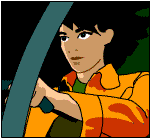Anime and Manga
Created | Updated Jan 28, 2002

'Manga' refers to a form of visual storytelling through pictures that originated in Japan, and anime, short for 'animation' is the animated (and possibly now more popular) form of manga, seen on TV and in cinemas. The easiest way to translate the word 'manga' to English would be to say that they are Japanese comic books. This definition, however, while technically true, is extremely misleading due to the connotations that the comic book has in Western culture. In the West, comic books refer to monthly booklets that tell a story, most of which are about heroes with ridiculous superpowers fighting stereotypical villains who just want to take over the world. American comic books are also similar in that they each tend to target the same demographic group: male children.
Manga is different in both respects. Manga fully penetrates the Japanese market, with manga for every demographic group, from little children to bored housewives to businessmen1. The actual content is very different from American comics, even on the level of children's manga - manga will often show a realistic portrayal of life, where death, angst, and the consequences of one's actions are a constant part of the story. These harsh facts of reality are often absent in American comic books where the protagonist seems to be able to do anything and forget the consequences. When manga and anime are translated into English they are often dumbed down, such as one example where in Sailor Moon, at the end of the Queen Beryl saga, each Sailor Senshi is killed until only Usagi (Serena) is left, who in the end kills Queen Beryl. In the American version, the Senshi aren't killed, they are 'removed' from the action, but are still alive.
One of the major differences is the level of depth to the characters in manga. In manga, one of the most important aspects is something often forgotten in American comic books - character development. Most manga worlds are populated with believable characters who have their own loves, hates and passions. Most enemy characters aren't evil - their agendas are just antagonistic to the protagonists' own plans. For example, in the recently translated Gundam Wing2, most of the characters have the same vision for the future; they are only fighting over how to achieve that vision.
Perhaps the greatest difference between manga and American comic books is how the stories tend to end. Unlike American comics, where the hero always comes back to fight another enemy, most manga have a definitive ending, whether it be a 'Hero wins, everybody's happy' type of ending, or an ending more akin to one of Shakespeare's tragedies. Manga ends with finality, rather than endless sequels.
Glossary
Bishonen are effeminate male characters usually seen in shojo manga (manga for girls and women) and animes.
A Cel is a single drawing on a piece of transparent material. Cels are laid over a background picture to produce a single frame of animation.
Chibi is a Japanese term referring to a person or thing's diminutive size, and is usually associated with cute things.
A Chroma Cel is a limited production, mechanically printed cel.
Cos-play is short for costume play. It refers to fans that dress up as characters at anime conventions, who may or may not put on a presentation in character.
A Doujinshi is fan-created manga featuring popular characters.
Ecchi is used to describe adult (erotic) anime and manga. It is written 'h' and read 'ecchi', coming from hentai, the Japanese word for pervert.
Fandub is an anime video re-dubbed by fans.
Fanfic is a story about popular characters written by fans.
Fansub is an anime from Japan that usually hasn't been released commercially in the US but has been subtitled using computers by fans.
Genga is a reference image used to help the camera operator line up the cel layers and backgrounds.
Hentai (literally 'strange forms') is anime with a pornographic edge to it.
Kawaii is the Japanese word for cute and attractive.
Kirei is the Japanese word for beautiful.
Manga (literally 'corrupt' pictures) are Japanese comic books.
Mecha is short for 'mechanised' and refers to a manga or anime that features powered suits or robots.
Otaku is a crazed fan of anything usually associated with manga and anime fans. It's a derogatory term in Japanese and is almost equivalent to the Japanese word for nerd, but is a term of endearment among some US fans.
OVA (or OAV) stands for Original Video Animation (or Original Animation Video). A higher quality straight to video release which has never been broadcast on TV.
PP cards are Japanese trading cards also known as Pull Pack cards. A bunch of envelopes containing a single card tied together with a string. In Japan these cards are typically sold one at a time.
Seiyuu is the Japanese word for 'Voice Actor'.
Shojo is the Japanese word for girl, associated with manga and anime aimed towards girls. The plots focus on emotion and relationships with pretty female main characters and attractive male supporting characters. An example is Sailor Moon.
Shonen is a Japanese word for boy, and is associated with manga and anime aimed towards boys
Super Deformed is an unusual caricature of an anime character usually with a huge head and a small body. It is used mostly in merchandising but sometimes in series (ie Lodoss Island, Tiny Goddess).
Yaoi is a male homosexually-themed anime/manga.
Yurie is a female homosexually-themed anime/manga.

